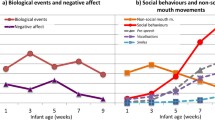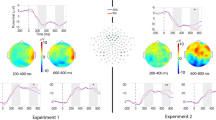Abstract
The power of an infantile appearance to elicit baby talk was investigated by assessing the use of baby talk in task instructions to four-year-old children, who were portrayed as either relatively babyfaced or maturefaced. Men and women taught two tasks to a randomly selected boy or girl via a telephone conversation after being shown a photograph, which presumably depicted the child whom they were instructing. Paralleling facial differences between babies and adults, babyfaced children had rounder faces, larger eyes, thinner eyebrows, and smaller noses than the maturefaced. As predicted, adults used more baby talk when instructing babyfaced than maturefaced children. This effect was manifested in linguistic indicators of baby talk (slow timing and high clarification, simplification, and attention maintenance), as well as in paralinguistic indicators of baby talk (high pitch and changing intonation). The receipt of linguistic baby talk, in turn, facilitated the child's ability to choose a card which matched the one being described. The fact that facial babyishness influenced baby talk even when baby- and maturefaced children were equated in age, attractiveness, and perceived competence suggests that a small approximation to the craniofacial qualities that distinguish infants from adults may in and of itself be sufficient to elicit this speech register.
Similar content being viewed by others
References
Berry, D. S., & McArthur, L. Z. (1986). Perceiving character in faces. The impact of agerelated craniofacial changes on social perception.Psychological Bulletin, 100 3–18.
Bohannon, J. N., & Marquis, A. L. (1977). Children's control of adult speech.Child Development, 48 1002–1008.
Brown, R. (1977). Introduction. In C. E. Snow & C. A. Ferguson (Eds.)Talking to children (pp. 1–27). Cambridge, England: Cambridge University Press.
Caporael, L. R. (1981). The paralanguage of caregiving: Baby talk to the institutionalized aged.Journal of Personality and Social Psychology, 40 876–884.
Caporael, L. R., Lukaszewski, M., & Culbertson, G. (1983). Secondary babytalk: Judgments by institutionalized elderly and their caregivers.Journal of Personality and Social Psychology, 44 746–754.
Cross, T. G. (1977). Mothers' speech adjustments: the contribution of selected child listener variables. In C. E. Snow & C. A. Ferguson (Eds.)Talking to children (pp. 151–188). Cambridge, England: Cambridge University Press.
DePaulo, B. M., & Coleman, L. M. (1986). Talking to children, foreigners, and retarded adults.Journal of Personality and Social Psychology, 51 945–959.
Dunn, J., & Kendrick, C. (1982). The speech of two- and three-year-olds to infant siblings: “Baby talk” and the context of communication.Journal of Child Language, 9 579–595.
Ferguson, C. A. (1964). Babytalk in six languages.American Anthropologist, 66 103–114.
Ferguson, C. A. (1977). Baby talk as a simplified register. In C. E. Snow & C. A. Ferguson (Eds.)Talking to children (pp. 209–235). Cambridge, England: Cambridge University Press.
Flavell, J. H., Botkin, P. T., Fry, C. L., Wright, J. W., & Jarvis, P. E. (1968).The development of role-taking and communication skills in children. New York: John Wiley & Sons, Inc.
Garnica, O. K. (1977). Some prosodic and paralinguistic features of speech to young children. In C. E. Snow & C. A. Ferguson (Eds.)Talking to children (pp. 63–88). Cambridge, England: Cambridge University Press.
Lorenz, K. Z. (1943). Die angeborenen Formen moglicher Erfahrung.Zeitschrift Fur Tierpsychologie, 5 235–409.
McArthur, L. Z., & Baron, R. M. (1983). Toward an ecological theory of social perception.Psychological Review, 90 215–238.
Rubin, K. H., & Brown, I. D. (1975). A life-span look at person perception and its relationship to communicative interaction.Journal of Gerontology, 30 461–468.
Ryan, E. B., Bourhis, R. Y., & Knops, U. (1991). Evaluative perceptions of patronizing speech addressed to elders.Psychology and Aging, 6 442–450.
Ryan, E. B., Giles, H., Bartolucci, G., & Henwood, K. (1986). Psycholinguistic and social psychological components of communication by and with the elderly.Language and Communication, 6 1–24.
Shatz, M., & Gelman, R. (1973). The development of communicative skills.Monographs of the Society for Research in Child Development, 38 (5, Serial No. 152).
Snow, C. E., & Ferguson, C. A. (Eds.). (1977).Talking to children. Cambridge, England: Cambridge University Press.
Snow, C., Arlman-Rupp, A., Hassing, Y., Jobse, J., Joosten, J., & Vorster, J. (1976). Mothers' speech in three social classes.Journal of Psycholinguistic Research, 5 1–20.
Thorndike, E. L., & Lorge, I. (1952).Teacher's word book of 30,000 words. New York: Teachers College Columbia University.
Zebrowitz, L. A., Kendall-Tackett, K., & Fafel, J. (1991). The influence of children's facial maturity on parental expectations and punishments.Journal of Experimental Child Psychology, 52 221–238.
Zebrowitz, L. A., & Montepare, J. M. (1992). Impressions of babyfaced males and females across the lifespan.Developmental Psychology, in press.
Author information
Authors and Affiliations
Additional information
This research was supported by NIMH grant #BSR5 R01 MH42684 to the first author. The authors would like to express their appreciation to the Brandeis University and Wellesley College Daycare Centers for their cooperation in this research. Thanks are also extended to Stacy Silberman for serving as one of the experimenters and to Becky Gilbert, Katina Lawdis, Sheryl Levy, and Liz Tighe for their help in coding the data.
Rights and permissions
About this article
Cite this article
Zebrowitz, L.A., Brownlow, S. & Olson, K. Baby talk to the babyfaced. J Nonverbal Behav 16, 143–158 (1992). https://doi.org/10.1007/BF00988031
Issue Date:
DOI: https://doi.org/10.1007/BF00988031




